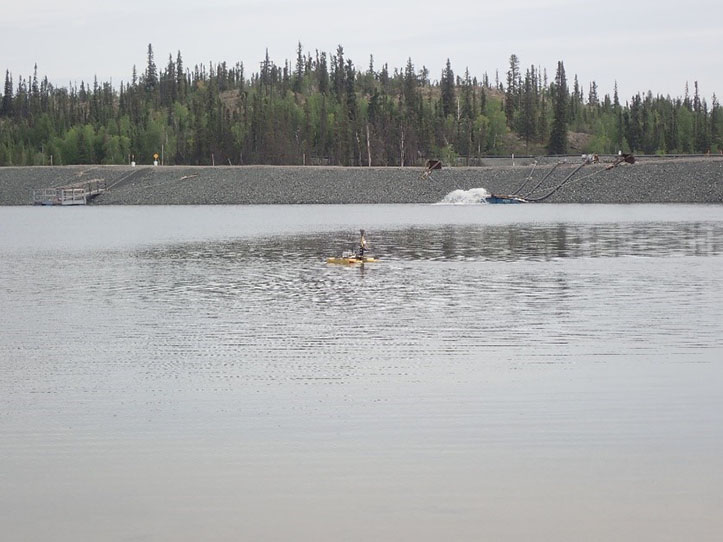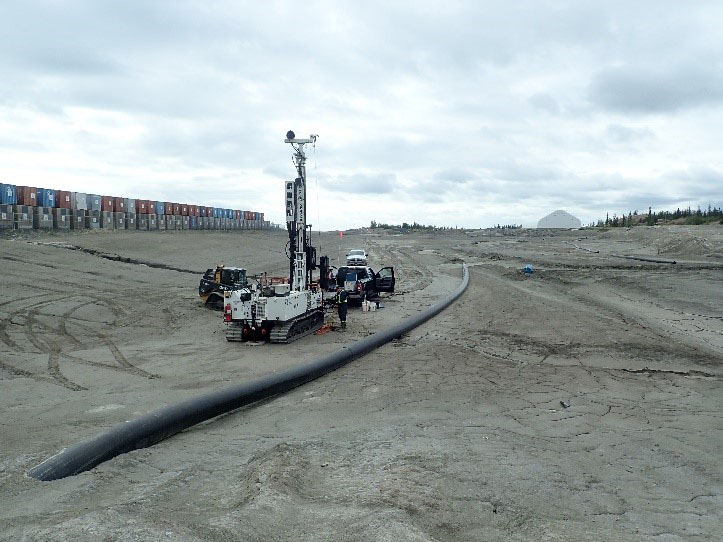Giant Mine newsletter: September to October 2019
Get the most recent updates on the Giant Mine remediation project.
On this page
Monitoring activities

The Giant Mine Remediation Project team continues to keep the site stable and secure while regulatory processes are underway. Monitoring at the site is ongoing, and covers a broad range of activities.
Site personnel keep an eye out for wildlife. Bears, wolves, coyotes, lynx, and porcupines, as well as other birds and animals common to the area, have been spotted at various times of the year. Wildlife continues to be observed and reported by those who spot it to Parsons Inc., which in turn reports back to the project team, to ensure the safety of both the animals and the people on site.
Air quality monitoring is essential for the continued safety of Northerners and the Giant Mine site. Through the Air Quality Monitoring Program, air samples are taken from 22 locations during a 24-hour period every 6 days.
The project team also monitors surface water and groundwater. Water quality is sampled from a number of different site locations. Over time, particularly after remediation, this will help the team determine if site conditions are changing.
In addition to routine monitoring, the team also tests surface rock around the site. The information will support the design of tailings covers and open pits.
Monitoring results have also helped to improve the Closure and Reclamation Plan, and they are used to update current surface care and maintenance practices.
Tailings drilling program

The tailings drilling program has continued throughout summer 2019. Contractors conducted drilling in the tailings area and the dams. The drilling helps the project team find out how deep the tailings are and to confirm the makeup of the tailings and tailings dams. This work will support the design plans for the tailings areas. This program included using a hydro drone (a small remote controlled boat) to conduct bathymetric surveys. Bathymetric surveys measure the depth of a water body and map the underwater features of a water body.
All 54 of the drill holes that were part of the summer drilling program were completed as of August 23, 2019.
Underground care and maintenance
This summer, the project team upgraded the underground power systems to better accommodate the future remediation of the site. The underground pumps were replaced with 2 submersible pumps. Contractors installed the pumps from the surface of the mine via 2 large diameter boreholes. The new pumps work to send water from the underground mine pool to the Northwest Pond, where it is stored until it can be treated and discharged. For more about this process, visit the water treatment webpage.
Dam inspections and assessment

As part of its work to keep the site safe and in regulatory compliance, the project team conducts annual inspections of all tailings dams on site. These inspections serve to assess management and maintenance needs for the dams.
This year, in addition to the annual geotechnical inspection of the dams, the project will undergo a 10-year dam safety review, as per the Canadian Dam Association Guidelines. This review will evaluate all aspects of design, construction, maintenance, operation, processes, and systems affecting a dam's safety. This is scheduled to take place in early October 2019.
Site security
Site security is another important part of the project. Over the summer months, the project team installed temporary fencing and additional signage around the marina area and old town site near the Ingraham trail to make the site boundaries more easily identifiable. The site is not open to the public, and trespassing is not allowed for health and safety reasons.
Technical sessions
Since April 1, 2019, the Giant Mine Remediation Project's water license and land use permit applications have been working their way through the regulatory process. The second set of technical sessions took place from September 11 to 13, 2019. The Mackenzie Valley Land and Water Board held the first set of sessions from July 9 to 12, 2019, after which the team responded to Information Requests, a formal part of the regulatory process. These responses are available on the Mackenzie Valley Land and Water Board's public registry, and the schedule for the technical sessions will be posted there as well. For more information, contact the Mackenzie Valley Land and Water Board. The Board will make the Information Requests and the team's responses from the second set of technical sessions available in a similar way. The next milestone, the Public Hearing segment of the regulatory process, is expected to take place in January 2020.
Completion of Measure 6 of the Report of Environmental Assessment
The Giant Mine Remediation Project team finalized its Measure 6 Report, which provides an analysis of funding options for consideration by the Government of Canada and Parliament. The report was prepared by the project team and contractor Deloitte, and was finalized with input from stakeholders. It is available on the project SharePoint site.
This report satisfies the requirement of the Report of Environmental Assessment Measure 6, which required the project to: "investigate long-term funding options for the ongoing maintenance of the project, including a trust fund with multi-year up front funding".
The Socio-economic Strategy
The Giant Mine Remediation Project team recognizes the potential impact of the Giant Mine remediation on the Northern economy. The team also recognizes that capacity is an issue across the Northwest Territories, and has developed and is implementing a socio-economic strategy that addresses how Indigenous persons and Northerners benefit from employment opportunities associated with the remediation of the Giant Mine. The strategy can be accessed by any interested party on the project's socio-economic folder of the SharePoint site. A plain language summary is also available on the website.